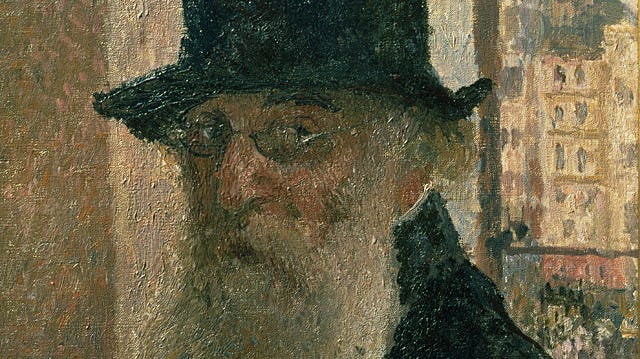Pissarro’s People at the Legion of Honor this Fall
Aug 30, 2011
Camille Pissaro, Self-Portrait with Hat, 1903. Tate Gallery, London. Presented by Lucien Pissarro, the artist's son, 1931
Pissarro’s People brings us face to face with one of the most complex and captivating members of the Impressionist group, a man whose life was as quietly revolutionary as his art. The exhibition, on view October 22, 2011, to January 22, 2012, offers a groundbreaking perspective on Camille Pissarro (1830–1903), the painter and printmaker best known for his large body of landscapes and urban views. This is the first exhibition to focus on Pissarro’s personal ties and social ideas through his lifelong engagement with the human figure.
Based on extensive new scholarship by curator Dr. Richard R. Brettell, the exhibition brings together more than one hundred oil paintings and works on paper from public and private collections around the world. Ranging from Pissarro’s earliest years in Paris until his death in 1903, these works explore the three dimensions of his life that are essential to a full understanding of the human element in his art: his family ties, his friendships and his intense intellectual involvement with the social and political theories of his time.
According to Brettell, “Scholars have tended to treat Pissarro’s politics and his art in two separate categories, often refusing to see the most basic connections between them. This is largely because Pissarro was less a political activist than a social and economic philosopher. The title of the exhibition, Pissarro’s People, is not merely an allusion to his politics, but points to a larger attempt to explore all aspects of his humanism. The exhibition embodies his pictorial humanism and creates a series of contexts, linking his web of family and friends to his profound social and economic concerns.”
Exhibition Highlights
Presiding over the powerful themes of this exhibition are three of the artist’s four major self-portraits, starting with his earliest Self-Portrait (1873) from the Musée d’Orsay, painted at the age of forty-three. Pissarro’s People is the first exhibition to bring these works together with portrait likenesses of every member of the artist’s immediate family, reflecting the importance that he attached to his roles as devoted husband and father.
Pissarro was the only Impressionist who made figure paintings in which the domestic worker is the central motif. The exhibition brings together an extraordinary group of paintings representing maidservants and washerwomen, including The Maidservant (1875, Chrysler Museum of Art), Washerwoman, Study (1880, The Metropolitan Museum of Art), The Little Country Maid (1882, Tate Collection) and In the Garden at Pontoise: A Young Woman Washing Dishes (1882, Fitzwilliam Museum, Cambridge). The key theme of domestic labor is linked, in turn, to Pissarro’s views on agricultural labor and the market economy in works such as The Harvest (1882, National Museum of Western Art, Tokyo), The Gisors Market (1887, Columbus Museum of Art) and his remarkable, biting album of anarchist drawings titled Turpitudes sociales (1889–90, private collection) which is being shown for the first time.
Pissarro held firm to the belief that the miseries of modern capitalist society would inevitably lead to revolution in Europe, and in his late multifigure rural genre paintings, he envisioned a better world as he imagined it would appear in the aftermath of such a momentous uprising. His late scenes of the grain harvest in Haymakers, Evening, Éragny (1893, Joslyn Art Museum), apple picking in Apple Harvest (1888, Dallas Museum of Art) and potato planting are utterly joyous in feeling, bathed in an idealized glow of light and health and abundance.
The Artist
Pissarro was in many ways a political and ethnic outsider in his adopted country of France. Born into a Sephardic Jewish family on the Danish colony of Saint Thomas in the Caribbean on July 10, 1830, he would never become a French citizen. He died a Danish citizen in Paris on November 13, 1903.
Pissarro’s lifelong interest in the human condition is unique among Impressionist landscape painters. From his early years in the Caribbean and Venezuela until his death, he produced a vast oeuvre of drawings, paintings and prints dedicated to the human figure. He was also a committed reader of radical social, political and economic theory. His profound knowledge of social philosophy, which informs much of his art, far exceeded that of any other significant painter of the period.
Programs
Saturday, October 22 \ 10 am–4:30 pm
Florence Gould Theater \ Legion of Honor
Symposium: Impressionism through the Lens of Pissarro
This scholarly symposium includes speakers Dr. Richard R. Brettell; Richard Kendall, Sterling and Francine Clark Art Institute; John House, Courtauld Institute; Joachim Pissarro, Hunter College; Paul Tucker, University of Massachusetts; and Nancy Mathews, independent scholar. Tickets are required.
Saturday, November 19 \ 2 pm
Florence Gould Theater \ Legion of Honor
Lecture: Figures in a Landscape: The Beauty of Pissarro’s People
Presented by Dr. James Housefield, University of California, Davis.
Organization
Pissarro’s People was organized by the Fine Arts Museums of San Francisco and the Sterling and Francine Clark Art Institute. It is supported in part by a grant from the National Endowment for the Arts and by an indemnity from the Federal Council on the Arts and the Humanities. The Grand Patron is Jeannik Méquet Littlefield. Education Sponsors are Denise Littlefield Sobel, Wells Fargo, and the S. D. Bechtel, Jr. Foundation. Sponsors are Nan and Ransom Cook, Raj and Helen Desai, and Charles and Ann Johnson. The catalogue is published with the assistance of the Andrew W. Mellon Foundation Endowment for Publications.
Catalogue
The catalogue Pissarro’s People is written by Dr. Richard R. Brettell, one of the world’s foremost authorities on Impressionism and French painting from 1830 to 1930. Richly illustrated with more than two hundred paintings, works on paper and archival images, this compelling volume offers a definitive portrait of one of the most passionately political painters of the nineteenth century. Pissarro’s People is available in the Museum Stores for $65 hardback and $39.95 paperback.
